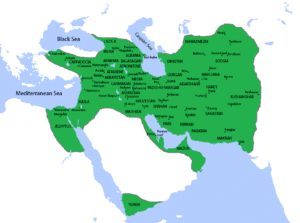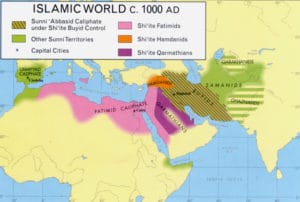Alexander had planned to settle Greek colonists on Bahrain, and although it is not clear that this happened on the scale he envisaged, Bahrain became very much part of the Hellenised world: the language of the upper classes was Greek (although Aramaic was in everyday use), while Zeus was worshiped in the form of the Arabian sun-god Shams. Bahrain even became the site of Greek athletic contests.
In the 3rd century, Ardashir I, the first ruler of the Sassanid dynasty, marched on Oman and Bahrain, where he defeated Sanatruq the ruler of Bahrain.

By the 5th century, Bahrain became a center for Nestorian Christianity, with the village Samahij as the seat of bishops. The names of several Muharraq villages today reflect Bahrain’s Christian legacy, with Al Dair meaning “the monastery”.
Time of Muhammad:
Muhammad’s first interaction with the people of Bahrain was the Al Kudr Invasion. Muhammad ordered a surprise attack on the Banu Salim tribe for allegedly plotting to attack Medina. He had received news that some tribes were assembling an army on Bahrain and preparing to attack the mainland. But the tribesmen retreated when they learned Muhammad was leading an army to do battle with them.
Traditional Islamic accounts state that Al-Ala’a Al-Hadrami was sent as an envoy during the Expedition of Zayd ibn Harithah (Hisma) to the Bahrain region by the prophet Muhammad in ad 628 and that Munzir ibn Sawa Al Tamimi, the local ruler, responded to his mission and converted the entire area.
Middle Ages:
In 899, the Qarmatians, a millenarian Ismaili Muslim sect, seized Bahrain, seeking to create a utopian society based on reason and redistribution of property among initiates. Thereafter, the Qarmatians demanded tribute from the caliph in Baghdad, and in 930 sacked Mecca and Medina, bringing the sacred Black Stone back to their base in Ahsa, in medieval Bahrain, for ransom. According to historian Al-Juwayni, the stone was returned 22 years later in 951 under mysterious circumstances. Wrapped in a sack, it was thrown into the Great Mosque of Kufa in Iraq, accompanied by a note saying “By command we took it, and by command we have brought it back.” The theft and removal of the Black Stone caused it to break into seven pieces.

Following their 976 defeat by the Abbasids, the Qarmatians were overthrown by the Arab Uyunid dynasty of al-Hasa, who took over the entire Bahrain region in 1076. The Uyunids controlled Bahrain until 1235, when the archipelago was briefly occupied by the Persian ruler of Fars. In 1253, the Bedouin Usfurids brought down the Uyunid dynasty, thereby gaining control over eastern Arabia, including the islands of Bahrain. In 1330, the archipelago became a tributary state of the rulers of Hormuz, though locally the islands were controlled by the Shi’ite Jarwanid dynasty of Qatif. In the mid-15th century, the archipelago came under the rule of the Jabrids, a Bedouin dynasty also based in Al-Ahsa that ruled most of eastern Arabia.
Early Modern Era:
In 1521, the Portuguese Empire allied with Hormuz and seized Bahrain from the Jabrid ruler Muqrin ibn Zamil, who was killed during the takeover. Portuguese rule lasted for around 80 years, during which time they depended mainly on Sunni Persian governors. The Portuguese were expelled from the islands in 1602 by Abbas I of the Safavid Empire, which gave impetus to Shia Islam. For the next two centuries, Persian rulers retained control of the archipelago, interrupted by the 1717 and 1738 invasions of the Ibadis of Oman. During most of this period, they resorted to governing Bahrain indirectly, either through the city of Bushehr or through immigrant Sunni Arab clans. The latter were tribes returning to the Arabian side of the Persian Gulf from Persian territories in the north who were known as Huwala. In 1753, the Huwala clan of Nasr Al-Madhkur invaded Bahrain on behalf of the Iranian Zand leader Karim Khan Zand and restored direct Iranian rule.
